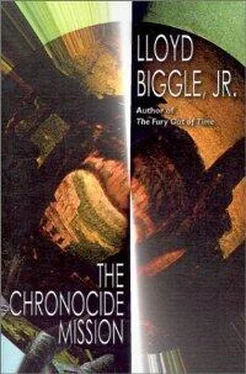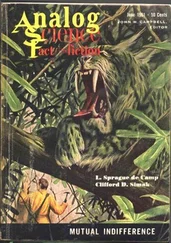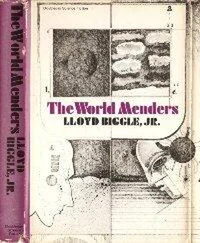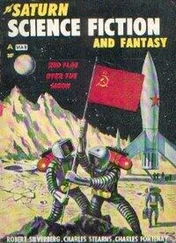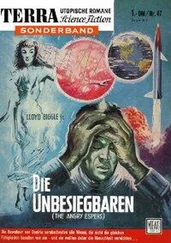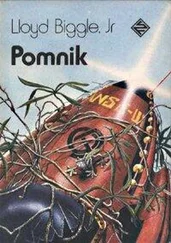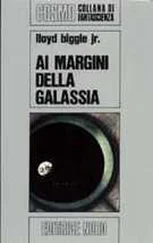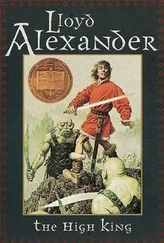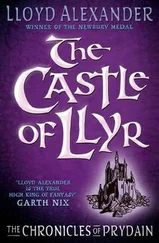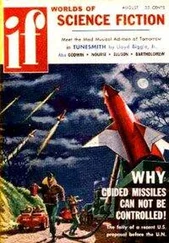Lloyd Biggle Jr. - The Chronocide Mission
Здесь есть возможность читать онлайн «Lloyd Biggle Jr. - The Chronocide Mission» весь текст электронной книги совершенно бесплатно (целиком полную версию без сокращений). В некоторых случаях можно слушать аудио, скачать через торрент в формате fb2 и присутствует краткое содержание. Год выпуска: 2002, ISBN: 2002, Издательство: Wildside Press, Жанр: Фантастика и фэнтези, на английском языке. Описание произведения, (предисловие) а так же отзывы посетителей доступны на портале библиотеки ЛибКат.
- Название:The Chronocide Mission
- Автор:
- Издательство:Wildside Press
- Жанр:
- Год:2002
- ISBN:978-1-58715-549-9
- Рейтинг книги:5 / 5. Голосов: 1
-
Избранное:Добавить в избранное
- Отзывы:
-
Ваша оценка:
- 100
- 1
- 2
- 3
- 4
- 5
The Chronocide Mission: краткое содержание, описание и аннотация
Предлагаем к чтению аннотацию, описание, краткое содержание или предисловие (зависит от того, что написал сам автор книги «The Chronocide Mission»). Если вы не нашли необходимую информацию о книге — напишите в комментариях, мы постараемся отыскать её.
The Chronocide Mission — читать онлайн бесплатно полную книгу (весь текст) целиком
Ниже представлен текст книги, разбитый по страницам. Система сохранения места последней прочитанной страницы, позволяет с удобством читать онлайн бесплатно книгу «The Chronocide Mission», без необходимости каждый раз заново искать на чём Вы остановились. Поставьте закладку, и сможете в любой момент перейти на страницу, на которой закончили чтение.
Интервал:
Закладка:
The marriage lasted two years, which was far longer than peeragers’ matings usually endured. There was one child, a daughter, who died young. They parted amicably, and when Egarn returned to the Old Med’s workrooms, he had made a lifelong friend.
So involved did he and the Old Med become with problems of history and with their Honsun Len experiments that Egarn gave no further thought to social or political matters until the old med died at an advanced age. Then the prince, who now was the peer, appointed him Med of Lant. This was more astonishing than her choice of him as consort. The med was the peerdom’s public health officer with responsibilities Egarn knew nothing about despite his long association with the Old Med. The appointment carried with it the lofty rank of Warden of the Peerdom, and only a peerager, a nobleman, could hold the position. But the Old Med had recommended him, and the peer appointed him, and no one dared object.
Egarn suddenly found himself administrator of a governmental bureaucracy that was, next to the army, the peerdom’s largest. He had a complexity of duties and a huge staff of med servers to perform them for him. Since Egarn’s arrival, the Old Med had ignored those duties. Many expected Egarn to do the same, but he wrenched himself away from his studies and doggedly set to work. He had long been the accidental guest of these people of Lant. They had treated him generously and given him high honors, and he had ignored them and their problems completely even though he knew from the beginning that his life was linked with theirs until death. Now he undertook to become a conscientious and competent Med of Lant.
What he learned on his first day in office horrified him.
This primitive society of the future was made up of rigid social classes, as he already knew. There were the peeragers, the age’s aristocrats. They had two names, in which they took overweening pride, and they guarded their class lineage with vehemence. Even as consort to the prince and father of a daughter who would have become peer if she had lived, Egarn, a one-namer, was not allowed to acquire a second name.
The one-namers were the peerdom’s crafters and skilled workers. They operated the mills, they wove, they baked, they engineered the roads, they built, they repaired, they kept the civilization functioning and its pathetically scant learning alive. As servers to those peeragers who headed the various governmental departments, they formed a type of civil service and actually ran the government. They also worked as personal servants to the peeragers and looked after their households. The few things they had no connection with were agriculture, any form of rough, heavy labor, and the military.
Rough labor was the responsibility of the work-humans, the no-namers, mentally deficient brutes who performed the most rigorous and exhausting labor under the lash without whimpering.
The no-namers’ supervisors were called lashers. They, too, were no-namers, but at least they were given numbers. No-name males who had slightly more mental capacity than others of their kind became lashers, and forever afterward their cruelly flicking whips peeled flesh from the backs of their fathers and brothers and cousins—and, ultimately, sons. The military drafted its soldiers from the ranks of the lashers.
Egarn watched the brutal way the lashers drove the no-name laborers and felt revolted. He was even more horrified when he discovered the abominable basis for these class distinctions.
The Honsun Len.
And he, as Med of Lant, was responsible for its use.
Not only was the Honsun Len the foundation of the grossly superstitious medicine practiced in this civilization, but it also was used to numb the minds of no-namers and lashers and keep them subjugated. The treatments started in infancy. All babies born to no-name females received their first Honsun Len exposure shortly after birth. The mothers trustingly took their newborn babies to the med servers for what they thought were beneficial medical treatments—if the mentally impaired no-name females were able to think at all. The babies’ still unformed minds were partially destroyed by rays from the Honsun Len, which focused energy out of nowhere. Such treatments were repeated throughout the no-namers’ lives. As a result, a class of mindless humans was condemned to a lifetime of uncomplaining, totally submissive, slave labor.
The lashers received a different course of treatments. Their minds were left more alert but still sadly impaired. This probably had nothing to do with their revolting characters. The fact that their entire lives were devoted to inflicting pain on others hardened them into unfeeling monsters.
The system had originated in the aftermath of the holocaust, Egarn reasoned. One petty state managed to subjugate another and then, with fiendish cleverness, used the len on its people, thus eliminating any possibility of revolt and at the same time originating the most loathsome form of slavery ever devised. From babyhood, the minds of the slaves were bound in shackles that could never be loosened.
As the system became entrenched, work-humans were bred to achieve the stature best suited to a human draft animal. The system had functioned so efficiently that human slaves now were far less costly to breed and maintain than horses would have been.
A baby’s schedule of treatments was predetermined by its alertness and stature. No-name females were left with sufficient mentality to enable them to rear children. Husky, more aggressive males became sub-moronic lashers and soldiers. The remaining no-name males were condemned to a lifetime of incessant labor that ended only when work or sickness killed them.
This shambles of a civilization was totally dependent on the system of slavery brought into being and maintained by the Honsun Len. But where had the Honsun Len come from? Egarn returned to his studies and eventually pieced isolated scraps of information into a staggering discovery. The Honsun Len had been invented at the end of the twentieth century by a man named Johnson, who had lived in Rochester, New York. Probably he had been a specialist in optics who worked in the photographic industry there. During his lifetime, the peculiar properties of his len made it an innocent curiosity, and only a few uses were found for it in children’s toys or household gadgets. It was not a subject of serious scientific research until certain military applications were discovered.
When that happened, civilization was doomed. The Honsun Len, adapted to war, unleashed the primal energy of the universe on the planet Earth. It devastated a world and annihilated much of its population. Mounted in artificial satellites, huge Honsun Lens wiped out armies, destroyed cities, cut enormous chasms across plains, leveled hills, piled up new mountains. Coastlines and the courses of rivers were altered. The Honsun Len changed the face of the planet and almost obliterated it.
Now it was about to destroy civilization a second time— thanks, in part, to Egarn, who rediscovered the military potential of the len and unthinkingly gave a few copies of a weapon to the Peer of Lant when she convinced him her peerdom was threatened by its neighbors. In between, it had destroyed the minds of two thirds of the surviving human race.
“A great pity,” Egarn mused, “that the Johnson who inflicted this curse on humanity didn’t die young.”
It was then that the great idea took possession of him: He could save humanity by destroying it. He had once read a story that posed a similar problem: Is it possible to change the present by journeying through time and altering the past? In the story, the quest failed. Egarn went over his plan again and again, trying to analyze it with cold logic, and he convinced himself it could succeed.
Читать дальшеИнтервал:
Закладка:
Похожие книги на «The Chronocide Mission»
Представляем Вашему вниманию похожие книги на «The Chronocide Mission» списком для выбора. Мы отобрали схожую по названию и смыслу литературу в надежде предоставить читателям больше вариантов отыскать новые, интересные, ещё непрочитанные произведения.
Обсуждение, отзывы о книге «The Chronocide Mission» и просто собственные мнения читателей. Оставьте ваши комментарии, напишите, что Вы думаете о произведении, его смысле или главных героях. Укажите что конкретно понравилось, а что нет, и почему Вы так считаете.
